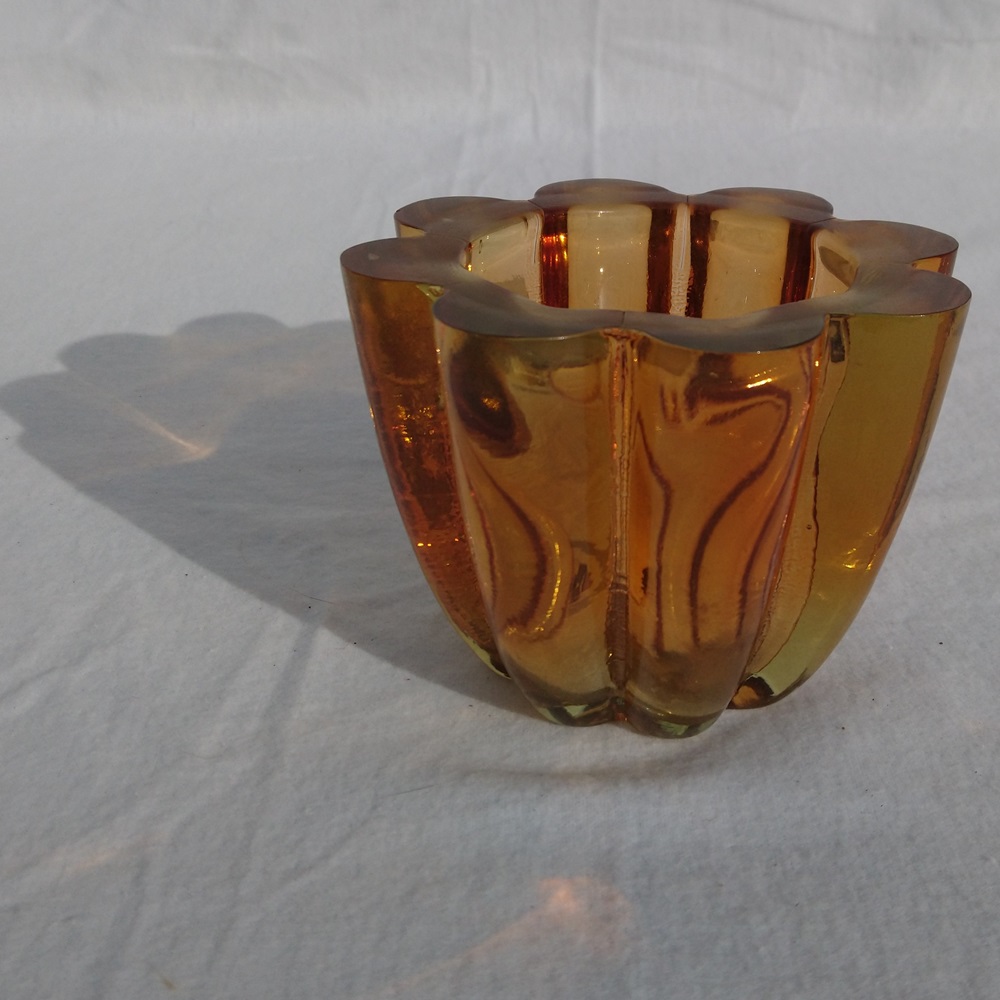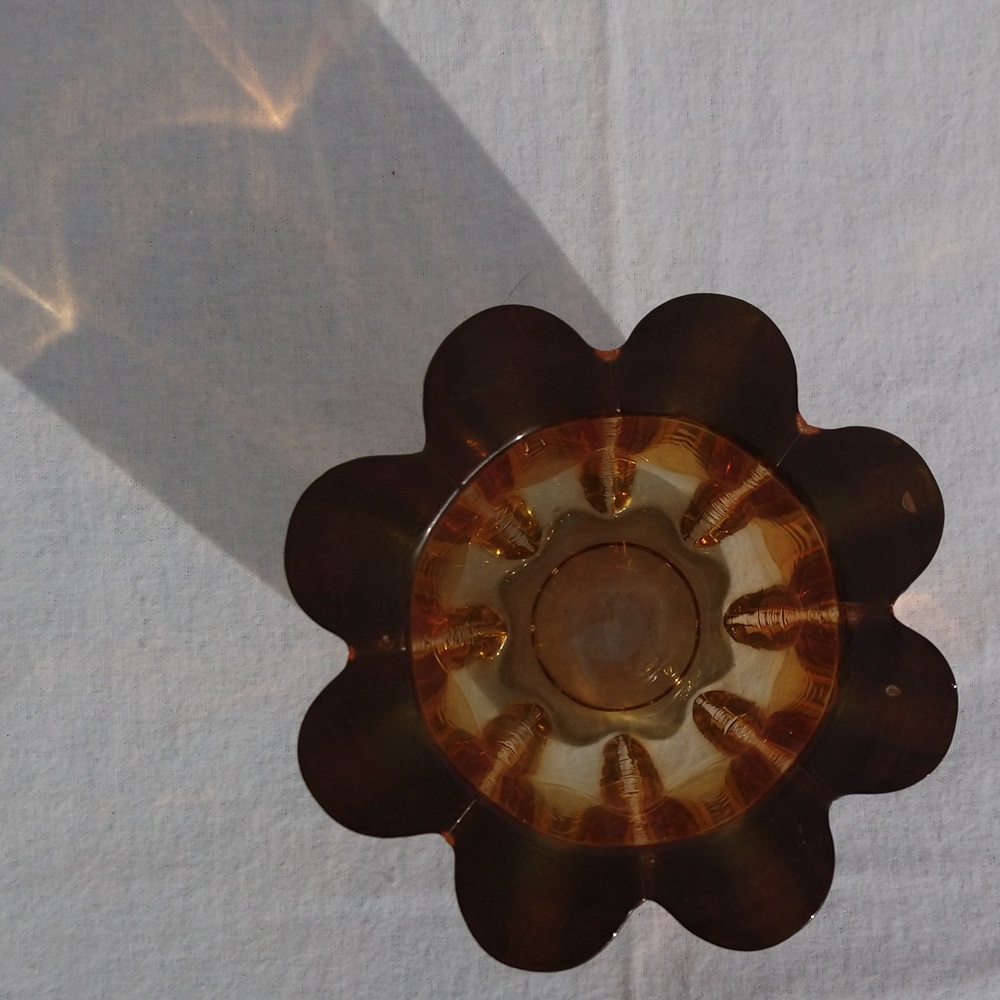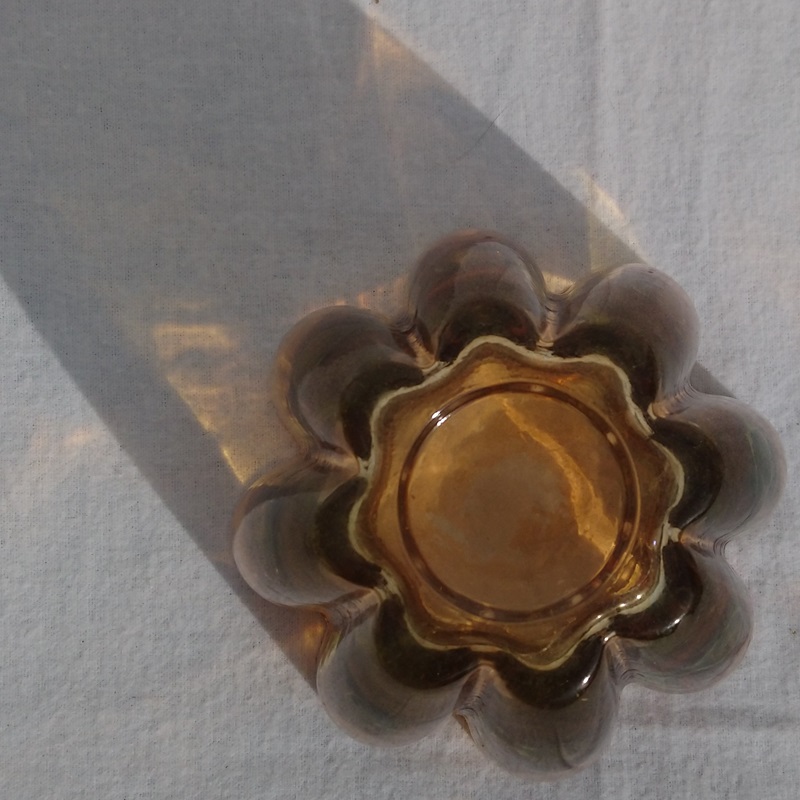



Vase en verre moulé-pressé des années 1960-1970 - Molded-pressed glass vase from the 1960s-1970s
20.00 €
Référence : 24-00093
Vase verre moulé pressé
Dimensions :Hauteur : 9,3 cm
largeur : 12,1 cm
Couleur dominante : marron orangé
Bon état.
Vase en verre moulé-pressé des années 1960/1970 de couleur marron orangé.
Il y a 100 000 ans, l'homme taille les premiers verres afin d'obtenir des pointes de flèches, des bijoux, à partir de roches magmatiques qui sont d'origine éruptive. Ce verre volcanique naturel s'appelle l'obsidienne mais les gisements sont rares.
C'est en Mésopotamie, que l'homme découvrit la fabrication de ses premiers verres : en recuisant ses poteries primitives, couvertes de végétaux issus du bord de mer ou de région désertique qui sont riches en sodium et potassium, la réaction chimique avec la silice contenue dans les poteries produisit un verre opaque de surface appelé "glaçure".
Avec l'apparition des fours à très hautes températures, le verre deviendra plus translucide et c'est sous le règne de Philippe II de Macédoine (382 Av. JC - 336 Av. JC), père d'Alexandre le Grand, que le verre deviendra transparent grâce à l'adjonction de dioxyde de manganèse qui purifie le verre en éliminant les oxydes qui le colorent.
Les techniques du verre telles que le soufflage du verre ou le verre moulé-pressé feront leurs apparitions.
La technique du verre moulé-pressé, inventée en 1827 par un Anglais, consiste à couler le verre en fusion dans un moule métallique en fonte ou en acier, puis à presser le verre fortement à l'intérieur de son moule afin qu'il en épouse parfaitement les formes. Cette technique a permis de donner à ce vase sa forme complexe dite "pétales".
Ce vase, de petite dimension assez lourd par son poids en verre, ne comporte aucune signature. Le verre n'est ni fêlé, ni brisé et ne présente aucun manque. Quelques bulles d'air prisonnières lors de sa fabrication sont visibles en transparence.
Cet objet pourra servir de vase pour un petit bouquet, de pot à crayons sur un bureau ou une coiffeuse, de seau à glaçons sur une table,...
Un petit vase tout en transparence !
 Click to translate into English
Click to translate into English
(Cliquez pour traduire en anglais)
Pressed molded glass vase
1960s/1970s molded-pressed glass vase in orange-brown color.
100,000 years ago, man cut the first glasses in order to obtain arrowheads, jewels, from magmatic rocks that are of eruptive origin. This natural volcanic glass is called obsidian but deposits are rare.
It was in Mesopotamia that man discovered the manufacture of his first glasses: by annealing his primitive pottery, covered with plants from the seaside or desert regions that are rich in sodium and potassium, the chemical reaction with the silica contained in the pottery produced an opaque surface glass called "glaze".
With the appearance of furnaces at very high temperatures, glass became more translucent and it was during the reign of Philip II of Macedon (382 BC - 336 BCE), father of Alexander the Great, that glass became transparent thanks to the addition of manganese dioxide which purified the glass by eliminating the oxides that coloured it.
Glass techniques such as glassblowing or molded-pressed glass will appear.
The molded-pressed glass technique, invented in 1827 by an Englishman, consists of pouring molten glass into a cast iron or steel metal mold, then pressing the glass strongly inside its mold so that it perfectly fits the shape. This technique made it possible to give this vase its complex shape called "petals".
This vase, small in size and quite heavy due to its glass weight, has no signature. The glass is not cracked, broken and has no gaps. A few air bubbles trapped during its manufacture are visible in transparency.
This object can be used as a vase for a small bouquet, as a pencil holder on a desk or dressing table, as an ice bucket on a table,...
Size :
Height : 9.3 cm
width : 12.1 cm
Dominant color : orange-brown
Good condition.
A small vase full of transparency !
1960s/1970s molded-pressed glass vase in orange-brown color.
100,000 years ago, man cut the first glasses in order to obtain arrowheads, jewels, from magmatic rocks that are of eruptive origin. This natural volcanic glass is called obsidian but deposits are rare.
It was in Mesopotamia that man discovered the manufacture of his first glasses: by annealing his primitive pottery, covered with plants from the seaside or desert regions that are rich in sodium and potassium, the chemical reaction with the silica contained in the pottery produced an opaque surface glass called "glaze".
With the appearance of furnaces at very high temperatures, glass became more translucent and it was during the reign of Philip II of Macedon (382 BC - 336 BCE), father of Alexander the Great, that glass became transparent thanks to the addition of manganese dioxide which purified the glass by eliminating the oxides that coloured it.
Glass techniques such as glassblowing or molded-pressed glass will appear.
The molded-pressed glass technique, invented in 1827 by an Englishman, consists of pouring molten glass into a cast iron or steel metal mold, then pressing the glass strongly inside its mold so that it perfectly fits the shape. This technique made it possible to give this vase its complex shape called "petals".
This vase, small in size and quite heavy due to its glass weight, has no signature. The glass is not cracked, broken and has no gaps. A few air bubbles trapped during its manufacture are visible in transparency.
This object can be used as a vase for a small bouquet, as a pencil holder on a desk or dressing table, as an ice bucket on a table,...
Size :
Height : 9.3 cm
width : 12.1 cm
Dominant color : orange-brown
Good condition.
A small vase full of transparency !



